Knockout Sculpt
Strength Conditioning by Dr. Julia Evergreen Keefer
This program is just an online teaser; for the detailed manual, contact <julia.keefer@nyu.edu>
Part Two: Knockout Sculpt
Effective, efficient strengthening routines.
(In Cognitive Performance, strength refers to argumentation. How strong is your claim, and how powerfully can you rebut your opponent's counterclaim? )
What is the best way to strengthen your muscles?
Ch07: MODALITIES: What Kind of Iron Should You Pump?
Dumbbells, barbells, bands, machines, resistance of gravity or a partner will give you different results.
Dumbbells
One problem for me is that with free weight training, the only muscles that burn out are my hands and rotator cuffs. With free weights, you can only lift what your weakest shred of muscle can support. Dumbbells are great for physical therapy, cardio sculpt, and to work different angles and range of motion, separating the right and left limbs.
Barbells
Barbells are good for explosive power lifting. They force you to work both sides of the body equally but they don't make allowances for individual quirks. If you have sweaty palms, they could slip.
Bands|
Bands increase resistance the harder and further you pull them so they work the opposite of a weight. Refer to Evergreen's Fitness for the Four Seasons to make the most of the EvergreenEnergy band outside. Combining the two is a great way to work out at home. 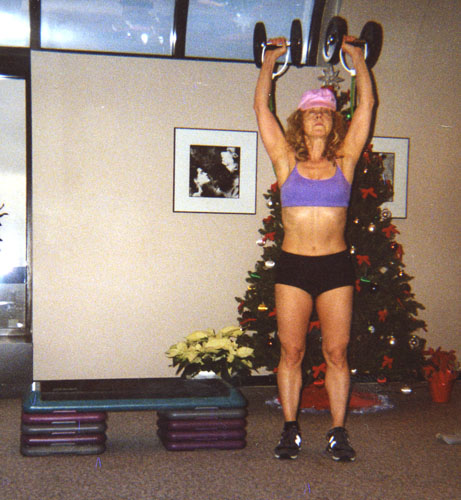 Bands can snap, break, or recoil suddenly. The negative phase is almost non-existent so release slowly.
Bands can snap, break, or recoil suddenly. The negative phase is almost non-existent so release slowly.
The Machine Circuit
In the old days, Nautilus had a monopoly on fitness machines. Now we have Cybex, Life Fitness ad infinitum. Machines give you back support and often a more isokinetic resistance than free weights, which is particularly useful for super slow. When lifting very heavy, machines are safer because you can't drop anything on yourself. However, they are cumbersome in home gyms and require maintenance, unlike free weights.
Overload, Don’t be a Toad
Because the body is constantly adapting to new training challenges, you need to keep increasing your weight to gain strength. Strength is measured by the maximum amount of weight you can lift with one repetition. Intensity refers to how much weight is lifted.
Beware health club body sculpters:
To keep lifting 5-10 pound weights for an hour month after month, year after year, without any cardio component or increase in the weight, is not the most effective use of your time. When you workout, are you increasing strength, getting your heart rate into your training zone, gaining flexibility, speed, coordination, balance and other movement skills, or having so much fun that it doesn't matter?
Pyramid--warm-up and cool-down with lighter weights. Peak with four to six intense reps.
Drop set--start as heavy as possible and lighten up. This could be a problem for people with joint issues or cardiovascular problems.
Building sets is good for circuit work where you just keep increasing the weight until you can't do it anymore.
Cardio sculpt requires you lift a light enough weight to keep doing exercises without stopping. You could start with this and then max out with 4 to 6 reps later on.
Ch08: MOVEMENT: Elephant, Giraffe, Tiger, Snake or Sparrow?
The joints can only flex, extend, abduct, adduct, and rotate alone or in combination, but that is enough to create the most complex patterns.
If you have joint problems or bad posture, return to Dr. Keefer's Corrective Clinic to work on prehab and rehab until you are happy hab enough to really lift weights. The struggle for good posture never ends. Pay attention to the five kinetic chains whenever you are lifting.
Five Kinetic Chains
1) Feet: Lift your arches, roll through your feet, wear proper shoes.
2) Knees: Don't bend knees more than ninety degrees if you are lifting a lot of weight. Keep kneecaps pointing towards second or third toe to avoid knock-knees or bow legs.
3) Lumbo-pelvic: Maintain a neutral pelvis by balancing the pubic pone and iliac crests on the same plane perpendicular to the floor. Avoid posterior or anterior pelvic tilt.
4) Shoulders and rib cage: Keep shoulders below ears and don't round upper back. Avoid scoliosis by maintaining an even right/left alighment of the spine and developing both sides of the back equally.
5) Neck: Avoid forward head by feeling eyes in the back of the head, pulling your ears over your shoulders in the correct plumb line.
Correct form by looking at five kinetic chains frequently as you lift.
Plies in Second Position
Overhead Press
Push-Ups and Presses
Standing Tricep Kickbacks
Rows and Raises
Bicep Curls and Deadlifts
Rotator Cuff, Supination and Pronation
Add seat belts after standing rotation exercises. Keeping the elbow lifted, rotate the shoulder inward bringing the hand to the opposite waist. It works a more functional angle of internal/external rotation.
Ch09: BODY POSITION
Moving, standing, sitting, on all fours, lying supine, lying prone, side-lying positions use levers against gravity in different ways.
Standing as you lift weights requires excellent posture and core strength.
Moving while you lift weights is good for coordination and cardio sculpt. You can walk, do low-impact aerobics, step, slide, or balance on a ball or BOSU.
Sit and Sculpt
You may spend most of your life sitting: at work, at meals, in the subway, the train, the plane, the bus, your car. Even if they are just little movements like circling your ankles, straightening your knees, shrugging your shoulders or looking to left and right-do them. There have been instances where people in planes got clots and even threw emboli during long plane rides.
Imagery
Establish good posture with the following images
Head as a Helium Balloon
Diamond Necklace to open your chest
Arms of Silk
Snakelike Spine
Once you are balanced on your sit bones, let your spine wiggle like a snake until you have equilibrium in all positions. Uncross your legs, contract abs and low back and lengthen upwards.
Tap the Toes, Anything Goes
Aerobics on the Chair
Put on some Big Band music and have your elderly parent or grandparent tap the toes and do the Lindy hop with his feet while sitting in a chair. To inspire my him, I used to dance in front of my father while he danced in the chair. Sometimes I would do jumping jacks and he mimicked me even though at that point he didn’t even know who I was.
Rock and Rock like a Ticking Clock
It is easy to strengthen the feet on the rocking chair.
Rock forward and place your feet flat on the floor. Point your toes hard to push your heels and then your forefeet off the floor as you rock backwards. The rockers will push you forward again. Land on your forefeet as a variation to strengthen the metatarsal arches.
To strengthen the evertors or peroneal muscles on the outside of the lower leg, land on the outer borders of the feet, roll through and push off with the little toes. Even a performance athlete can get some mileage out of this exercise during foot rehab.
Neck and Shoulder Stretches
Hold on to the side of the chair with your right hand. Lean your left ear to your left shoulder until you feel a stretch in the right trapezius or neck muscles. Repeat on the other side. 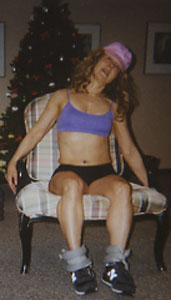
Some office chairs allow you to lean backwards, arching your back. Do this as a chest stretch and circle your arms up, back and down in this extended position. Keeping your arms overhead, turn to the right and to the left.
Rotator Roll
Turn the arms and legs in and out to work the six rotators of the hips, and the four rotators of the shoulders. 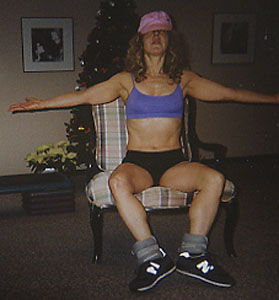
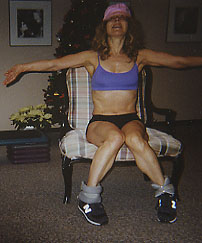
Side Bends
Correct your sitting posture to make sure you are on your sit bones, not your tail bone. Place your fingertips lightly on the top of your head. As you exhale, contract your abdominals and bend sideways, touching your right elbow to your right hip. Return to the upright position. Repeat on the other side.
and Spinal Twist.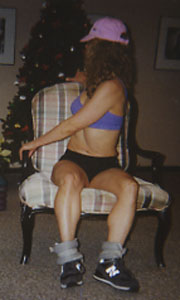
Seated Crunch-down.
Hands on head. Exhale, contract abs, and fold torso in half. Level III can add a weight. 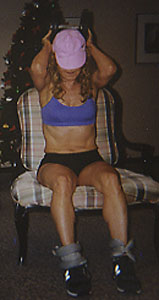
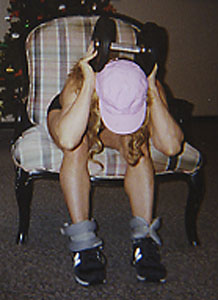 Return slowly to sitting position.
Return slowly to sitting position.
Single knee raises.
Start with feet flat on the floor. Contract abdominals and try not to round back. Keep chest lifted as you bring one knee to chest. Lower slowly and repeat. Do multiple reps of one leg to make it harder. 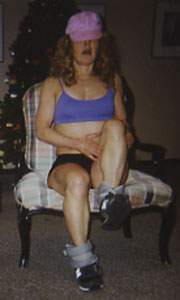 More advanced exercisers can do double knee raises. The most advanced version is a jackknife, where you sit back on chair and lift both legs. Hold underneath the seat with both hands. As you exhale lift both legs as high as you can. Lower slowly.
More advanced exercisers can do double knee raises. The most advanced version is a jackknife, where you sit back on chair and lift both legs. Hold underneath the seat with both hands. As you exhale lift both legs as high as you can. Lower slowly.
Seated Fly
Attach the band behind the chair and hold to equal ends. Strengthen the chest muscles by opening and closing the arms at shoulder level. 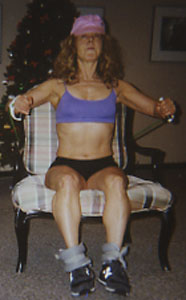
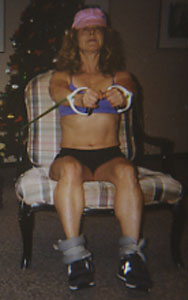
Lateral Raises
Step on the band and exhale the arms straight out to the sides to strengthen the middle deltoid muscles. 
Overhead Press
Step on the band 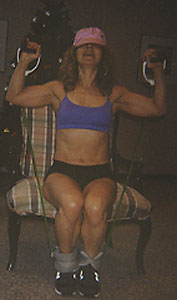 and press the arms and weights over the head to strengthen the trapezius and deltoid muscles.
and press the arms and weights over the head to strengthen the trapezius and deltoid muscles.
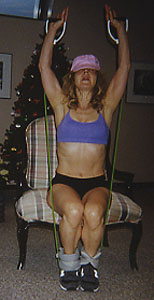 Exhale on this exertion and contract abs, keeping back straight, neck long, and shoulders down.
Exhale on this exertion and contract abs, keeping back straight, neck long, and shoulders down.
Quads
Bend and straighten your knees without rounding your back to strengthen quads. Lengthen the Legs
Bend and straighten the knees, singly and together. 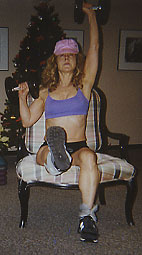 With the legs straight, do a flat back to stretch the back and hamstrings. Here I combine overhead presses with leg extensions. Complex/compound movements also burn more calories.
With the legs straight, do a flat back to stretch the back and hamstrings. Here I combine overhead presses with leg extensions. Complex/compound movements also burn more calories.
Squats
Sit and rise from the chair, keeping your buttocks back. Lower yourself gently into a chair, don’t just collapse. Practice getting up and down by doing squats.
Add weights to increase difficulty. 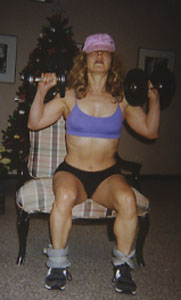
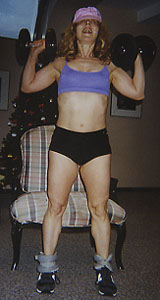
 When you sit down again, make sure your chair seat is soft enough that it doesn't bruise your coccyx, or tail bone.
When you sit down again, make sure your chair seat is soft enough that it doesn't bruise your coccyx, or tail bone.
Calf Muscles
Put a weight on top of your thighs as you lift your heels up and down to strengthen the soleus muscles.
Wood Chops
A loaded briefcase can be used in lieu of an axe, weight or ball. Hold it as you bring your arms overhead and back down, as you twist side to side or reach across the diagonal in a wood chopping motion.
Dips
Sit on the edge of a stable chair, preferably backed up against the wall. Place your hands on either side of your upper thighs, fingers pointing forwards. Legs are bent at right angles or straight and separated for more advanced students. Shuffle off chair, taking body weight into arms. Flex elbows and lower your buttocks towards the floor. Return to your start position by straightening your elbows.
Then do tricep kickbacks 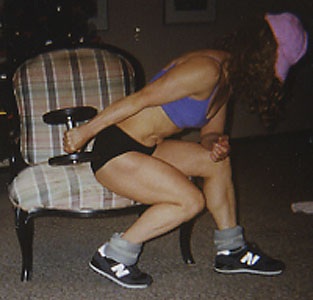 followed by bicep curls.
followed by bicep curls. 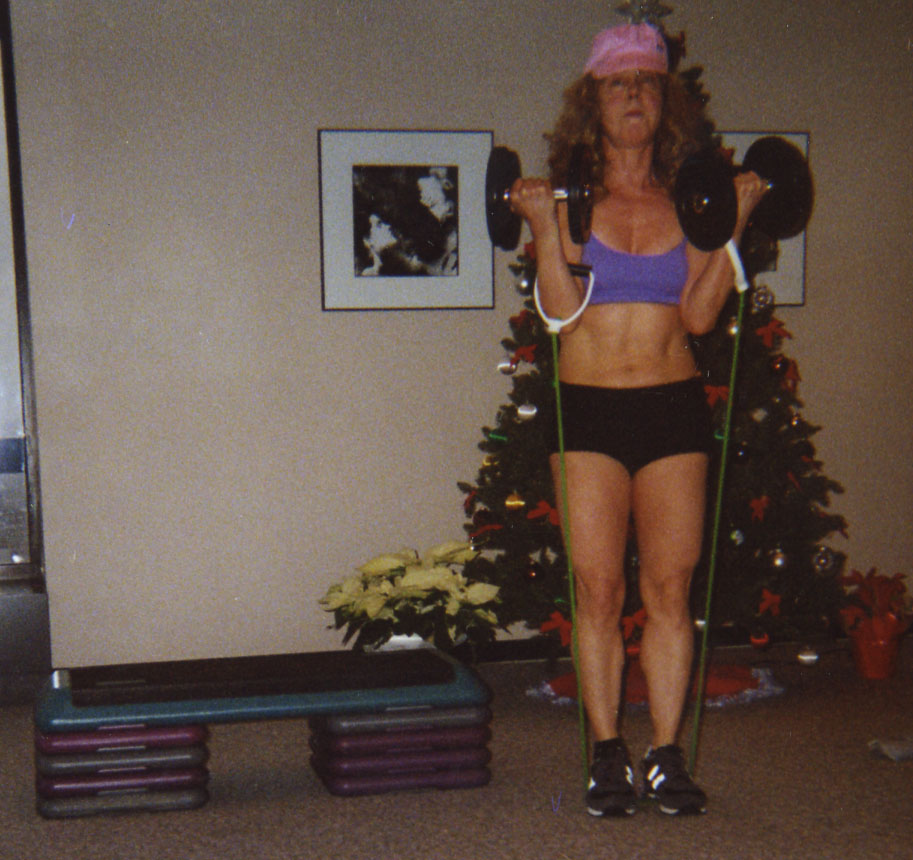
Standing by the Chair
In the seated position the focus is on flexion, so make sure you stand up, hold on to the back of the chair and do leg curls, bending your heel to your buttocks, leg lifts to the side and back, calf raises and stretches. You can also bend back a bit to stretch your abdominals. As in any exercise, it is as important to exercise the front as the back of the body.
Do a hip flexor stretch. Sit to the right side of a stable chair without arm rests. Keep your left flat on the floor in front of your chair. Bend your right knee behind the chair, with the ball of the right foot on the floor behind your chair so you are in a lunge, gradually extending the right leg as much as possible. Lift your back and contract your right buttocks pushing your pelvis forward.
Lying down burns fewer calories but allows you to work muscles in a way you can't while standing or sitting. It is safe unless the weight drops on you.
Lying Supine
Use a bench to increase lever disadvantage. Best position to target chest muscles and abs.
Lying Prone
Use a bench to increase lever disadvantage. Best position to isolate rear deltoid, back and buttocks.
Side-Lying
Best position to isolate ab-adductors, rotators of legs and arms. Keep hips stacked and pelvis perpendicular to the floor.
Ch10: SEQUENCE
Isolate muscle groups, work functionally, superset, agonist/antagonist, or do split routines of upper/lower body or push/pull.
Isolated
Head-to-Toe
Toe-to-Head
Functional Combinations
Superset
Agonist/Antagonist
Upper/Lower Body
Push/Pull
Ch11: TEMPO
Achieve different results by changing the duration from static strength to slow, medium, fast, and explosive.
3 major types of fiber-type-I slow twitch, type-IIa strength and endurance, type-II-b explosive. Usually we use slow controlled weight lifting, but to get ready for kicking, hitting, sprinting, jumping, blocking or throwing you need power lifting.
A challenging yoga class or a ballet adagio uses static strength.
Slow circuit work is great, particular to strengthen the negative phase, but some people could bulk up too much and lose speed if they don't do enough cardio and explosive exercise.
Most body sculpting classes work at a medium pace.
Athletes use fast, explosive weight training, called power lifting, to help them for performance. Dancers could make better use of this as well, provided they leave sufficient recovery time.
Ch12: RECOVERY
Rest for five minutes, stretch in between, work with a partner, continue from set to set, combine weight training with aerobics,or pepper it with cardio sprints.
Cardio sculpt combines aerobics with muscular endurance for 30 to 60 minutes, changing muscle groups and incorporating aerobic drills such as step-ups, jumping rope, jumping jacks, kicks and punches, squat thrusts, mountain climbers etc. Make sure you are getting a heart rate and don't neglect strength training. You may only need one set of 6 reps of heavy weight lifting afterwards.
Power sculpt by definition is for explosive training with max weight--no more than 4 reps. To lift heavy weight quickly requires a thorough warm-up that is not exhausting and plenty of rest time between reps. With power lifts, no more than 6 reps or 3 sets. Rest at least two minutes before sets. Warm up thoroughly but don’t exhaust yourself with complete aerobic and strength training. Too much power lifting can give you tendonitis or even rip them.
Slow sculpt refers to slow eccentric training with maximum negative resistance for 7 to 12 reps. This can build bulk and slow you down if you don't do some cardio but is great for injury prevention and will puff up the belly of the muscle for competition. Ample recovery time between reps and sets is essential.
Isolated sculpt is for PT. This is only to fix the weak links for more integrated training.
Functional Sculpt is complex-compound moves with moderate speed and resistance and no intense aerobic component--more like daily living.
KNOCKOUT STEP/SLIDE/STRIKE
KNOCKOUT BALLET 'N BOX
KNOCKOUT CARDIO-CORE with AEROBIC GUT AND BUTT
EVERGREENENERGY
Dr. Keefer's Corrective Clinic
 Bands can snap, break, or recoil suddenly. The negative phase is almost non-existent so release slowly.
Bands can snap, break, or recoil suddenly. The negative phase is almost non-existent so release slowly. 




 Return slowly to sitting position.
Return slowly to sitting position.  More advanced exercisers can do double knee raises. The most advanced version is a jackknife, where you sit back on chair and lift both legs. Hold underneath the seat with both hands. As you exhale lift both legs as high as you can. Lower slowly.
More advanced exercisers can do double knee raises. The most advanced version is a jackknife, where you sit back on chair and lift both legs. Hold underneath the seat with both hands. As you exhale lift both legs as high as you can. Lower slowly. 


 and press the arms and weights over the head to strengthen the trapezius and deltoid muscles.
and press the arms and weights over the head to strengthen the trapezius and deltoid muscles.  Exhale on this exertion and contract abs, keeping back straight, neck long, and shoulders down.
Exhale on this exertion and contract abs, keeping back straight, neck long, and shoulders down.  With the legs straight, do a flat back to stretch the back and hamstrings. Here I combine overhead presses with leg extensions. Complex/compound movements also burn more calories.
With the legs straight, do a flat back to stretch the back and hamstrings. Here I combine overhead presses with leg extensions. Complex/compound movements also burn more calories.

 followed by bicep curls.
followed by bicep curls. 